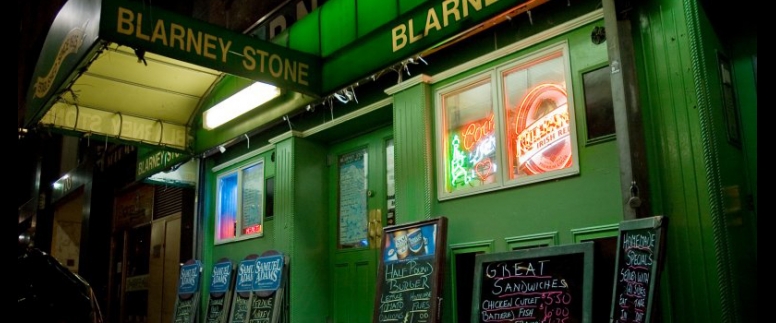
Now that the sainted day of Erie, St. Patrick’s Day has passed, American Bars can openly report a disturbing fact — America’s Irish Pubs are dying off.
Yes, it is sad to tell you that the number of Irish bars in America is in decline. The only way to save them is to get to the bar, and enjoy the craic.

You may not have noticed it last week, as the bars were jammed with St Patrick’s Day revelers. But, despite drinking crowds wearing their giant green, white, and orange hats, loudly making merry and a brief revival of Gaelic folk music, it is all vanishing. The worst part is we’re all partially to blame.
This decidedly downward trend is mostly due to a notable switch in American drinking preferences.The excitement of imbibing in a slick, new Starbucks Evenings location or a sharp craft beer and hip-cocktail bar has replaced the comfort and familiarity of the Ye Olde neighborhood tavern, which, as a result, is struggling to survive. Perception is everything and the traditional Irish pub is often viewed by the younger set as “my parent’s bar.” That equates with certain death.
Even in Irish-strongholds New York and Boston nearly 40% of those city’s traditional pubs have closed up in the last ten years. Irish pubs go quietly into that good night, with a single soulful voice singing “Danny Boy” as a requiem and a farewell.
In Chicago, the situation isn’t much better. Actually, it is now worse given that bar owners have had to contend with City Hall, which, according to USA Today, has cut the available number of tavern licenses by more than half over last couple decades.
Dale DeGroff, the father of the rebirth of the cocktail, has also seen this change in other large cities, including LA and San Francisco. “A whole younger generation is drinking a different way,” he says.
One specific reason for the decline (among many) is that many of these traditional, antique watering holes have missed out on the recent craft-whiskey and craft-beer, custom wine booms, preferring to serve old standbys instead of even attempting to serve new upstarts like the offerings from Venice Duck Brewery or those various satanic/zombie themes like Alesmith Evil Dead Red.
And now that Irish whiskey sales are skyrocketing in America—up an astronomical 637% from 2002 to 2015, according to the Distilled Spirits Council of the United States—you can find a wide selection of the Emerald Isle’s liquor in most watering holes, not just the hallowed Irish pubs. Yes, people are actually learning to pronounce Tullamore DEW.
Having popularized that category of booze, pubs are perhaps now victims of genre success. What used to be restricted to Irish themed holes in the wall are now found in mainstream and leading edge night spots.
Don’t get us wrong here at American Bars. Even the most On-the-Mark thriving establishments must be ever more nimble and aware, offering a fresh atmosphere and engaging environment depending upon the hour of the day and the day of the week. Once again, we refer to the outstanding marketing and presentation of the Starbucks Evenings concept for a sample.
Danny McDonald, who runs six of New York’s most popular Irish pubs, including Swift Hibernian Lounge, Ulysses’ and Puck Fair, maintains that he is still bullish on the basic model, but concedes that he is, at the end of the day, “in the business of selling atmosphere.”
Meanwhile, commercial rents, according to real estate service firm CBRE, continue to climb across the country, while supply remains tight. That makes it harder and harder for restaurants and bars to get favorable leases or lease renewals.
“When the restaurants get pushed, the bars get pushed further,” says David Orkin, CBRE’s Restaurant Practice Leader Emeritus. So, the economic element strikes from all sides.
While some Irish bars have found a way to go upscale, like New York’s award-winning The Dead Rabbit (which McDonald co-owns) and the cavernous The Local in Minneapolis, most, according to DeGroff, would find it “impossible” to charge $15 a drink.
At the bar, as the old Cheers theme song suggested, there was a good chance that you’d know the names of the other patrons and the bartender would surely be able to anticipate your regular order.
Not that many years ago it would have seemed impossible that the Irish pub would disappear.
It, like the coffee shop, was a staple of modern American cities. They were so commonplace they hid in plain sight. But, if you can imagine, they were even more ubiquitous at the end of the 19th century, when “they were pretty much on every block,” says Michael Lerner, author of Dry Manhattan: Prohibition in New York City.
The local bar was “a lot more than a place to drink beer. It fulfilled a range of social functions.” The bar served as a bank, a post office and a political and job center for a community. And, according to Lerner, the poorer the neighborhood the more pubs it had.
Unbelievably, the loss-of-Irish-bars trend is also happening in Ireland, which has watched an unprecedented number of its beloved pubs close. American Bars will be reporting on that shocking trend soon. Stay tuned!
Things got particularly bad in 2013, when it was reported that 1,500 establishments had been shuttered since 2008. The slide has slowed, but is still of concern.
What can we do to reverse the trend? Be a patron! Belly up to the bar of your local Irish pub before it’s too late and order yourself a pint and a shot. If nothing else, it forestalls the inevitable.




